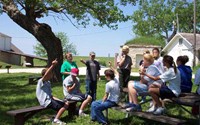- Lesson Plan (729)
- Field Trips (235)
- Distance Learning (171)
- Student Activities (141)
- Traveling Trunk (42)
- Other Education Materials (34)
- Teacher Reference Materials (25)
- Guest Speakers (17)
- Science Labs (14)
- Field Schools & Institutes (9)
- Media for Loan (9)
- Teacher Workshops & Other Programs (5)
- Primary Sources (3)
- Teacher-Ranger-Teacher (2)
- Online Galleries (1)
- Acadia National Park (111)
- Glacier National Park (86)
- Everglades National Park (64)
- Haleakalā National Park (44)
- Olympic National Park (39)
- Shenandoah National Park (31)
- Abraham Lincoln Birthplace National Historical Park (28)
- Sleeping Bear Dunes National Lakeshore (28)
- National Park of American Samoa (27)
- Show More ...
- Science (1,212)
- Social Studies (519)
- Literacy and Language Arts (344)
- Math (186)
- Upper Elementary: Third Grade through Fifth Grade (633)
- Middle School: Sixth Grade through Eighth Grade (416)
- Lower Elementary: Pre-Kindergarten through Second Grade (228)
- High School: Ninth Grade through Twelfth Grade (119)
- Adult Education (7)
- Graduate Level (Masters (3)
- PhD) (3)
- College Undergraduate Level (1)
Showing 1,407 results for science curriculum ...
Hō‘ike o Haleakalā: High School Science Curriculum
Brown Curriculum Unit
- Type: Traveling Trunk
- Grade Levels: Middle School: Sixth Grade through Eighth Grade

The Brown Foundation and the National Park Service worked closely to produce this curriculum to provide teachers the resources needed to teach concepts of fairness and social democracy.The Brown curriculum kit includes a Brown v. Board of Education National Historic Site handbook; a DVD with two short videos titled Reading, Writing and Resistance and Dialog; and a CD-ROM entitled Brown v. Board of Education: Struggle for Equality with a teacher's guide.
Teaching With Historic Places Curriculum
- Type: Lesson Plan
- Grade Levels: Middle School: Sixth Grade through Eighth Grade
Students will show what they have learned by drawing and writing about their “flipped” animal to encourage creativity and thoughtful response in how these adaptations help their animals survive in their unique environments. As an extension, students can do further research on specific animals and their adaptations by making “What Am I?” cards to play in class.
Web Quest Curriculum Unit
- Type: Student Activities
- Grade Levels: Middle School: Sixth Grade through Eighth Grade
Tallgrass Prairie: A Multidisciplinary Curriculum
- Type: Student Activities ... Teacher Reference Materials
- Grade Levels: Middle School: Sixth Grade through Eighth Grade

Prepare students for a visit to the 81-acre tallgrass prairie at Herbert Hoover National Historic Site. Activities strenghten skills in observation, analysis, and interpretation in the field and in the classroom. Activities are written with middle school students in mind, but may be appropriate for other ages.
Science on the Prairie
Environmental Prairie Science
The Science of Sled Dogs
- Type: Distance Learning
- Grade Levels: Upper Elementary: Third Grade through Fifth Grade

Did you know that park rangers use sled dogs to perform winter work in Denali National Park and Preserve? But why? Join us to learn about why these amazing animals are perfectly adapted to a cold, subarctic environment. Take a deeper dive into what makes the tails, fur, feet, and dispositions of Denali’s sled dogs so good for their snowy, hard work!
Introduction to Citizen Science
- Type: Lesson Plan
- Grade Levels: Middle School: Sixth Grade through Eighth Grade

Citizen Science is the involvement of everyday people in making scientific observations of the world around us. These observations address real world problems and contribute to scientific research projects. Citizen Science initiatives provide opportunities for the public to collect data in the field and report findings to databases used by professional scientists. Introduce your students to this growing field, in which amateur scientists can contribute meaningful observations to science.
Kaloko Loko I'a (Fishpond) Curriculum
- Type: Lesson Plan
- Grade Levels: High School: Ninth Grade through Twelfth Grade

Kaloko-Honokōhau is a wahi kūpuna (ancestral place) that is deeply loved and cherished by the kamaʻāina (natives) of Kona. Remembered today for the fishing village that existed along the coast, these reminders of the ancestors remain. Remnants of the fishing village includes kahua (ancient house site platforms), heiau (religious sites), loko iʻa (fishponds), holua (toboggan slide), kiʻi pōhaku (petroglyphs), papamū (kokane game boards), ahu (altar), and ala hele(trails).
Climate Science in Focus (Evaluations)
Exploring Climate Science: Snowpack
Exploring Climate Science (Watershed)
Women in Science at Grand Canyon
Exploring Climate Science: Watersheds
- Type: Lesson Plan
- Grade Levels: Upper Elementary: Third Grade through Fifth Grade

In “Exploring Climate Science (Watersheds),” students will explore the local watershed to learn how communities, the region, and state are connected by water. The students will be able to: 1. State the watershed(s) in the area and explain why it is important. 2. Show how the watershed connects their town to others in the area/region
Southern Paiute Cultural History Curriculum Guide
- Type: Student Activities ... Teacher Reference Materials
- Grade Levels: Middle School: Sixth Grade through Eighth Grade

The purpose of the Southern Paiute Cultural History supplemental curriculum lessons is to provide opportunities for students to learn about the region’s cultural history. Studying about past cultures and traditions provide a context for deeper understanding that links today’s Southern Paiute people with their rich cultural legacy. Archeology helps to provide a better understanding of these connections.












